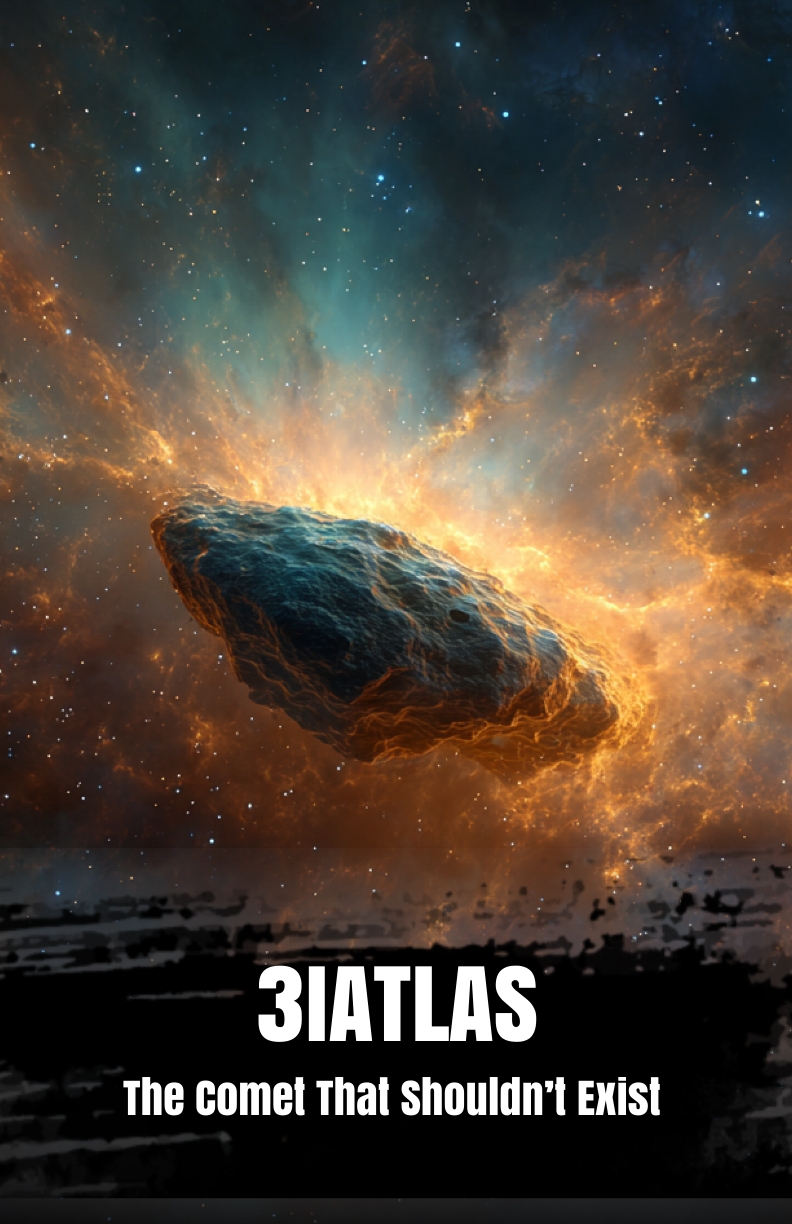Your cart is currently empty!
The Crawling Ice

An unreleased short story from the book: 3I/ATLAS: The Comet That Shouldn’t Exist
They told us the ice came from the comet.
Not in the poetic way that snow once fell from the heavens, but in the raw, physical sense—fragments torn loose from 3I/ATLAS, flung into the atmosphere during its pass, and somehow surviving the plunge to Earth.
When I first saw it, it was barely larger than my fist, a lump of glassy white lodged in a hollow of the ridge. The thing steamed faintly in the sub-zero air, as though it held its own weather inside.
The wind screamed across the mountain, dragging clouds of frozen grit into my face, and yet the ice… moved.
It shifted with a faint grinding sound, like teeth scraping glass, dragging itself upward against the slope, against gravity, leaving behind a furrow in the snow. The trail it carved froze instantly, the moisture hardening into a ridge of ice that glinted pale blue in the weak light.
It had been five days since the meteorologists confirmed the debris field over this part of the range. Four since the first teams went up to retrieve samples. Only two since we’d lost radio contact with them.
The official line was equipment failure. But on the third day, a search party brought back a rope, frozen so stiff it was brittle as bone, still knotted into the shape of a human hand.
The fragment in front of me quivered like something breathing. My crampons bit into the crusted snow as I crouched closer, breath pluming white. I could see faint striations inside it—threads of darker material that shifted when I moved my head, almost like the thing was refracting not light but movement itself.
I thought about my gloves—two layers of wool and Gore-Tex—then reached out.
The moment I touched it, the cold went through me like a spike. Not the surface sting of frost, but something deeper, a sinking pressure in my bones. My fingernails ached as though they were being pulled from within.
I snatched my hand back. Frost bloomed instantly across the glove, patterns spiraling outward like skeletal fingers.
We’d been warned about the comet’s chemistry. ATLAS, formerly designated A11pl3Z, had been an enigma since its discovery. Astronomers noted its erratic spin, the green halo of cyanogen and diatomic carbon in its coma, and—most unsettling—the shifts in its spectrographic profile as it neared the Sun, as though the heat was waking something inside it.
Whatever had fallen here wasn’t just ice. It was alive in the only way frozen things could be—patient, enduring, older than our species.
That night, at base camp, the wind brought a sound down from the ridge. Not quite a howl. Not quite a voice. A cracking, stretching noise, as though glass were being pulled slowly apart.
I lay in my tent, listening, and smelled something faint under the sharp cold: a mineral tang, like wet stone and metal left too long in the dark.
In the morning, the trail outside camp was no longer a smooth sweep of snow. Long, narrow ridges of ice wound their way down from the ridge, like the trails left by giant snails, except these were finger-thick and translucent, with trapped bubbles that seemed to squirm slowly inside.
One of them had reached the outer edge of the camp.
We followed it uphill.
The ridges grew taller the higher we climbed. Two feet. Four. Twisting columns like frozen roots, gripping at the slope. And at the top of each column—always—the same shape: a lump of comet ice, glistening wet in the weak sunlight, pulsing faintly as though something inside it moved.
The wind here was stronger, but the ice moved faster than before. We saw one shift in real time, dragging its growing column a few inches toward a man standing too close.
He stumbled back. The ice stopped moving.
By midday we found the first of the missing.
She was kneeling, head bowed, arms hanging limp. Her parka and hood were crusted solid with frost, but her face was bare to the air—skin pale, lips split, eyes wide and rimmed with tiny fractures of ice that stretched out from the corners like spiderwebs.
A column had grown up from the snow beneath her, cupping her ribcage, its fingers of ice pressed delicately into her back as if in embrace.
When we touched her, the ice tightened.
We cut the column at its base, dragged her away. The fingers remained locked in her skin, fused through fabric and flesh alike.
She didn’t blink the entire time.
That night the ridges reached the edge of camp again.
I was on watch when one brushed against the outer wall of my tent. The contact was so soft I might have imagined it, except the cold went straight through the nylon into my bones.
I took a light and followed the ridge away from camp. It twisted between tents, its surface clear enough to show a faint movement inside—something like hair drifting in water.
After fifty yards, it ended in a lump of ice the size of my head. As my light hit it, the lump shivered.
A crack ran through its center.
Inside, something pale and long uncoiled.
We didn’t sleep after that.
The next day we packed to descend, but the ridges had grown faster overnight, some as thick as tree trunks, curling across each other, forming arches overhead. They were no longer reaching just toward us—they were connecting, building a lattice across the slope.
A cage.
By the fourth night, the cold wasn’t just outside. I could feel it in my chest when I breathed. My exhales came out faintly crystalline.
Others had it too. We avoided looking at each other for too long, afraid of seeing frost blooming at the corners of our eyes.
The sound from the ridge was louder now, a chorus of slow, grinding glass. And beneath it, almost too soft to hear—footsteps.
The last thing I saw before my radio froze solid was a column rising beside me, higher and higher, until the lump of ice at its tip hung over my head like a poised drop.
The crack split wider.
And the thing inside leaned down.
If you enjoyed this short story you will probably like our latest release available now:
3I/ATLAS: The Comet That Shouldn’t Exist
It came from the darkness between the stars… and it should not be here.
When astronomers first spotted 3I/ATLAS—officially designated C/2025 N1 (ATLAS)—they thought it was just another icy visitor from the edge of our solar system. But within days, the data told a far stranger story. This was no ordinary comet.

Leave a Reply